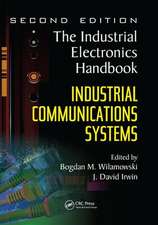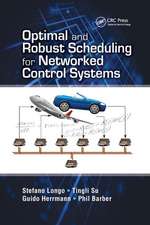A Journey into the World of Exponential Functions
Autor Gautam Bandyopadhyayen Limba Engleză Hardback – 16 iun 2023
This book clearly illustrates why such abstract mathematical entities are needed to represent some aspects of physical reality. It provides an overview of different types of numbers and functions along with their historical background and applications. It contains four chapters covering number system, exponential function, logarithmic functions and hyperbolic functions along with the concept of complex angle.
Print edition not for sale in South Asia (India, Sri Lanka, Nepal, Bangladesh, Pakistan or Bhutan)
Preț: 639.04 lei
Preț vechi: 702.24 lei
-9% Nou
Puncte Express: 959
Preț estimativ în valută:
122.28€ • 133.24$ • 103.04£
122.28€ • 133.24$ • 103.04£
Carte disponibilă
Livrare economică 02-16 aprilie
Livrare express 18-22 martie pentru 27.12 lei
Preluare comenzi: 021 569.72.76
Specificații
ISBN-13: 9781032526867
ISBN-10: 1032526866
Pagini: 164
Dimensiuni: 152 x 229 x 17 mm
Greutate: 0.4 kg
Ediția:1
Editura: CRC Press
Colecția CRC Press
ISBN-10: 1032526866
Pagini: 164
Dimensiuni: 152 x 229 x 17 mm
Greutate: 0.4 kg
Ediția:1
Editura: CRC Press
Colecția CRC Press
Public țintă
Postgraduate, Undergraduate Advanced, and Undergraduate CoreCuprins
1. On Different Types of Numbers
1.1 The beginning of the journey
1.2 Extension of Number Field
1.2.1 Negative Number
1.2.2 Fraction and Rational Number
1.2.3 Irrational Number
1.2.4 Imaginary (or Quadrature Number)
1.2.5 Quaternion
1.2.6 Infinitesimal and Hyper-real Numbers; Bibliography
2. On e & ex
2.1 Introduction
2.2 Backdrop in which e emerged as the outcome of continuous compounding
2.3 Outcome of decrease through continuous compounding
2.4 e as an infinite series
2.5 Proof of convergence of two sequences of e
2.6 Proof of Irrationality of e
2.7 Function ex
2.8 Interesting features of exponential functions ex and emx
2.9 Story of snails or an informal explanation of e1 vis-à-vis ei
2.9.1 e as a distance travelled along a road
2.9.2 ei as a distance travelled in a field
2.10 General function eiθ = limn→∞(1 + iθ/n )n
2.11 Infinite series representation of cos θ and sin θ
2.12 Raising the power of e by complex angle (α + iθ)
2.13 Rotating vector and concept of complex frequency
2.14 cos θ and sin θ in terms of exponential functions
2.15 Ellipse from two rotating planar vectors
2.16 Problems related to division of a number
2.16.1 Maximisation of the function x x
2.16.2 Dividing a number into several equal parts such that their product is maximum
2.17 Minimisation of the function xx
2.18 Computation of ii
2.19 Examples of 1st order differential equation
2.20 Example of 2nd order differential equation
2.21 Miscellaneous examples
2.21.1 Radioactive Disintegration
2.21.2 Advance of Chemical Reaction
2.21.3 Logistic growth
2.22 Matrix Exponential eA
2.23 Chronology of development of concepts related to e ; Bibliography
3. Logarithm
3.1 Introduction
3.2 Logarithm as artificial numbers facilitating computation
3.3 Logarithmic Function as an integral
3.4 A story of the historical development of logarithm as an area
3.5 Reverse Problem
3.6 Some useful properties of logarithmic functions
3.7 Expressing logarithm as a series
3.7.1 Alternate Method of Derivation of Logarithmic Series
3.7.2 Searching for a method with a higher rate of convergence
3.7.3 Further improvement of the method described in section 3.7.2
3.8 Logarithmic curves
3.8.1 Observations on the curve for the function y = ln x
3.8.2 Curve for the function y = ln(–x ) and y = ln |x |
3.9 Leibnitz-Gregory Series for π
3.10 Schellbach’s modified series for π
3.11 Logarithm as a limit of a product
3.12 Torricelli’s Trumpet
3.13 Logarithm of a complex number
3.14 Resolving an apparent contradiction
3.15 Applications 3.15.1 Inductance of a two wire line
3.15.2 Capacitance of a two wire line
3.15.3 Loudness of sound
3.15.4 Magnitude of earthquake
3.15.5 Acidity of a substance
3.16 Chronology of development of the concepts related to logarithm; Bibliography
4. Concept of Complex Angle and Hyperbolic Functions
4.1 Introduction
4.2 Angle in terms of the area swept over during rotation
4.3 Vector viewpoint and the concept of imaginary angle
4.4 Angle due to stretching or shrinking and the concept of real angle
4.5 Complex Angle
4.6 Hyperbolic angle and Hyperbolic Functions for a hyperbola
4.7 Area swept by a straight line moving over a hyperbola
4.8 From the hyperbola x 2 – y 2 = 1 to the hyperbola u.v = 1126
4.9 Calculation of hyperbolic angle from the curve v = 1/u
4.10 The tip of a straight line moving over the curve v = 1/u 129
4.11 Trigonometric functions of imaginary variable and Hyperbolic functions
4.12 Trigonometric and Hyperbolic functions of complex angle α + iβ
4.13 Applications
4.13.1 A DC Voltage Source (V) is switched on to an LC circuit
4.13.2 A DC Voltage Source is switched on to a RLC circuit
4.13.3 Catenary 4.13.4 A Leaky Direct Current Line
4.13.5 Dynamics of moving bodies
4.14 Graphs of different hyperbolic functions
4.15 Are the hyperbolic functions periodic?
4.16 Expressions for inverse hyperbolic functions
4.17 Infinite series representation of cosh x and sinh x
4.18 Historical Development of the concept of hyperbolic functions ; Bibliography
1.1 The beginning of the journey
1.2 Extension of Number Field
1.2.1 Negative Number
1.2.2 Fraction and Rational Number
1.2.3 Irrational Number
1.2.4 Imaginary (or Quadrature Number)
1.2.5 Quaternion
1.2.6 Infinitesimal and Hyper-real Numbers; Bibliography
2. On e & ex
2.1 Introduction
2.2 Backdrop in which e emerged as the outcome of continuous compounding
2.3 Outcome of decrease through continuous compounding
2.4 e as an infinite series
2.5 Proof of convergence of two sequences of e
2.6 Proof of Irrationality of e
2.7 Function ex
2.8 Interesting features of exponential functions ex and emx
2.9 Story of snails or an informal explanation of e1 vis-à-vis ei
2.9.1 e as a distance travelled along a road
2.9.2 ei as a distance travelled in a field
2.10 General function eiθ = limn→∞(1 + iθ/n )n
2.11 Infinite series representation of cos θ and sin θ
2.12 Raising the power of e by complex angle (α + iθ)
2.13 Rotating vector and concept of complex frequency
2.14 cos θ and sin θ in terms of exponential functions
2.15 Ellipse from two rotating planar vectors
2.16 Problems related to division of a number
2.16.1 Maximisation of the function x x
2.16.2 Dividing a number into several equal parts such that their product is maximum
2.17 Minimisation of the function xx
2.18 Computation of ii
2.19 Examples of 1st order differential equation
2.20 Example of 2nd order differential equation
2.21 Miscellaneous examples
2.21.1 Radioactive Disintegration
2.21.2 Advance of Chemical Reaction
2.21.3 Logistic growth
2.22 Matrix Exponential eA
2.23 Chronology of development of concepts related to e ; Bibliography
3. Logarithm
3.1 Introduction
3.2 Logarithm as artificial numbers facilitating computation
3.3 Logarithmic Function as an integral
3.4 A story of the historical development of logarithm as an area
3.5 Reverse Problem
3.6 Some useful properties of logarithmic functions
3.7 Expressing logarithm as a series
3.7.1 Alternate Method of Derivation of Logarithmic Series
3.7.2 Searching for a method with a higher rate of convergence
3.7.3 Further improvement of the method described in section 3.7.2
3.8 Logarithmic curves
3.8.1 Observations on the curve for the function y = ln x
3.8.2 Curve for the function y = ln(–x ) and y = ln |x |
3.9 Leibnitz-Gregory Series for π
3.10 Schellbach’s modified series for π
3.11 Logarithm as a limit of a product
3.12 Torricelli’s Trumpet
3.13 Logarithm of a complex number
3.14 Resolving an apparent contradiction
3.15 Applications 3.15.1 Inductance of a two wire line
3.15.2 Capacitance of a two wire line
3.15.3 Loudness of sound
3.15.4 Magnitude of earthquake
3.15.5 Acidity of a substance
3.16 Chronology of development of the concepts related to logarithm; Bibliography
4. Concept of Complex Angle and Hyperbolic Functions
4.1 Introduction
4.2 Angle in terms of the area swept over during rotation
4.3 Vector viewpoint and the concept of imaginary angle
4.4 Angle due to stretching or shrinking and the concept of real angle
4.5 Complex Angle
4.6 Hyperbolic angle and Hyperbolic Functions for a hyperbola
4.7 Area swept by a straight line moving over a hyperbola
4.8 From the hyperbola x 2 – y 2 = 1 to the hyperbola u.v = 1126
4.9 Calculation of hyperbolic angle from the curve v = 1/u
4.10 The tip of a straight line moving over the curve v = 1/u 129
4.11 Trigonometric functions of imaginary variable and Hyperbolic functions
4.12 Trigonometric and Hyperbolic functions of complex angle α + iβ
4.13 Applications
4.13.1 A DC Voltage Source (V) is switched on to an LC circuit
4.13.2 A DC Voltage Source is switched on to a RLC circuit
4.13.3 Catenary 4.13.4 A Leaky Direct Current Line
4.13.5 Dynamics of moving bodies
4.14 Graphs of different hyperbolic functions
4.15 Are the hyperbolic functions periodic?
4.16 Expressions for inverse hyperbolic functions
4.17 Infinite series representation of cosh x and sinh x
4.18 Historical Development of the concept of hyperbolic functions ; Bibliography
Notă biografică
Gautam Bandyopadhyay is former Professor and Head in the Department of Electrical Engineering, Indian Institute of Engineering Science and Technology (IIEST), Shibpur. He started his career as a Design Engineer at a consultancy organisation in Kolkata where he was associated with the design of electrical systems of thermal power plants. In 1986 he transitioned to a career in academics where he stayed till retirement in 2020. He served as a faculty in the Electrical Engineering department of IIEST, Shibpur for over 33 years.
Descriere
This book illustrates why abstract mathematical entities are needed to represent some aspects of physical reality. It provides an overview of different types of numbers and functions along with their historical background and applications.













